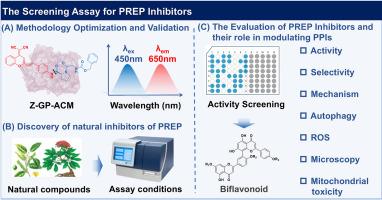近红外荧光底物驱动下发现脯氨酸内肽酶天然抑制剂及其抑制α -突触核蛋白聚集和促进自噬
IF 5.4
2区 医学
Q1 BIOCHEMISTRY & MOLECULAR BIOLOGY
引用次数: 0
摘要
脯氨酸内肽酶(PREP)通过酶活性和蛋白相互作用(PPIs)的双重机制驱动神经退行性疾病,但目前的抑制剂主要针对单一途径。脯氨酸内肽酶(PREP)通过酶促裂解和病理性PPIs促进神经变性,但目前的抑制剂通常只针对一个方面。在本研究中,利用我们开发的高灵敏度和高特异性的近红外荧光探针Z-GP-ACM,我们建立了一个用小鼠脑S9代替人重组PREP的筛选平台,并对其进行了验证。筛选了110个天然化合物库,鉴定出一系列类黄酮衍生物(FV64-FV68)为有效的PREP抑制剂,其中FV67和FV68的抑制作用特别强(IC50值分别为0.65 μM和0.31 μM)。可逆性实验显示,所有新抑制剂的效价与时间无关(孵育前5分钟和孵育前35分钟IC50不变),证实了可逆性抑制。动力学分析将FV66/FV67分为混合型,FV64/FV65/FV68为非竞争性抑制剂。分子对接模拟进一步揭示了FV68通过氢键和π-π堆积结合PREP的S1和S2亚位点,这是其高活性的结构基础。进一步研究表明,FV67和FV68均能抑制HT22和SH-SY5Y细胞的PREP活性,且呈剂量依赖性。值得注意的是,FV68增强了自噬,减少了α-突触核蛋白聚集,减轻了h2o2诱导的氧化应激。这些研究不仅为天然产物衍生的新型PREP抑制剂的开发提供了方向,也揭示了天然化合物通过抑制PREP调节PPIs干预神经退行性疾病的新机制。本文章由计算机程序翻译,如有差异,请以英文原文为准。

NIR fluorescent substrate-driven discovery of prolyl endopeptidase natural inhibitors and its inhibition of alpha-synuclein aggregation and promotion of autophagy
Prolyl endopeptidase (PREP) drives neurodegenerative diseases through dual mechanisms involving enzymatic activity and protein-protein interactions (PPIs), yet current inhibitors predominantly target single pathways.
Prolyl endopeptidase (PREP) fuels neurodegeneration via enzymatic cleavage and pathological PPIs, yet current inhibitors usually target only one facet. In this study, leveraging our developed high-sensitivity and high-specificity near-infrared fluorescent probe Z-GP-ACM, we established and validated a screening platform for PREP inhibitors with mouse brain S9 instead of the human recombinant PREP.
Screening a library of 110 natural compounds identified a series of flavonoid derivatives (FV64-FV68) as potent PREP inhibitors, with FV67 and FV68 exhibiting particularly strong inhibition (IC50 values of 0.65 μM and 0.31 μM, respectively). Reversibility assays revealed that all new inhibitors display time-independent potency (IC50 unchanged after 5 vs 35 min pre-incubation), confirming reversible inhibition.
Furthermore. Kinetic analyses classified FV66/FV67 as mixed-type and FV64/FV65/FV68 as non-competitive inhibitors. Molecular docking simulations further revealed that FV68 binds the S1 and S2 sub-sites of PREP through hydrogen bonding and π-π stacking, which is the structural basis for its high activity. Further studies showed that both FV67 and FV68 inhibited PREP activity in HT22 and SH-SY5Y cells with a dose-dependent manner. Notably, FV68 enhanced autophagy, reduced α-synuclein aggregation, and mitigated H2O2-induced oxidative stress. These studies not only provide directions for the development of novel PREP inhibitors derived from natural products, also reveal new mechanisms by which natural compounds may intervene in neurodegenerative diseases by PREP-inhibited modulating PPIs.
求助全文
通过发布文献求助,成功后即可免费获取论文全文。
去求助
来源期刊
CiteScore
7.70
自引率
3.90%
发文量
410
审稿时长
36 days
期刊介绍:
Chemico-Biological Interactions publishes research reports and review articles that examine the molecular, cellular, and/or biochemical basis of toxicologically relevant outcomes. Special emphasis is placed on toxicological mechanisms associated with interactions between chemicals and biological systems. Outcomes may include all traditional endpoints caused by synthetic or naturally occurring chemicals, both in vivo and in vitro. Endpoints of interest include, but are not limited to carcinogenesis, mutagenesis, respiratory toxicology, neurotoxicology, reproductive and developmental toxicology, and immunotoxicology.

 求助内容:
求助内容: 应助结果提醒方式:
应助结果提醒方式:


